I have a really long and intricate post today, so I’m gonna leave it at the top for the most of the week so you can absorb it and comment. But first, I need to mention that I’ll be reading at City Lights in North Beach on Wednesday, January 31st at 7 pm. As their announcment puts it: “Legendary novelist, mathematician, computer scientist, and cyberpunk innovator visits City Lights for an evening of readings, conversation, and synchronicity in action.” I’ll try and podcast it.
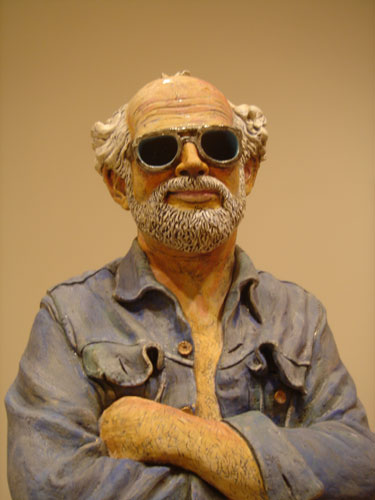
[“California Artist” sculpture by Robert Arneson. This was one of the first works of art I saw when I moved out here 20 years ago. Note that the artist’s head is empty; those “mirrorshades” are black holes. It’s like the artist is saying, “Yeah, we’re flaky in California. You got a problem with that?”]
I recently turned in a novel called Postsingular, or PS1 for short, and now I’m working on a sequel called PS2. Last week I was calling the new novel After Everything Woke Up, but today my working title for the new novel is Hylozoic, which means “relating to hylozoism,” where hylozoism is the doctrine that every object is alive.

I’m working on a series of notes for ideas for my new book PS2. So far we’ve had
PS2 Note #1: Talking to Objects,
and today’s PS2 Note #6: The Noospheres of PS1 and PS1. Later, maybe this Friday, I’ll post PS2 Note #7: Teleportation. And then for PS2 Note #8, I’ll do a post which summarizes some of the comments you readers have made on PS2 Notes 1-7. This post will be similar in form to the Postsingular Comments post I did last February 14, 2006, when I was getting reader input for some of the ideas for PS1. So go ahead and post some comments on this long note today. The comments can relate to any of the earlier PS2 Notes as well.
In today’s entry’s title, I’m using the word “noosphere” to refer to a planet’s collective forms of mind. Just as the biosphere includes all living things, or the atmosphere includes all the air, the noosphere includes all the minds on the planet.
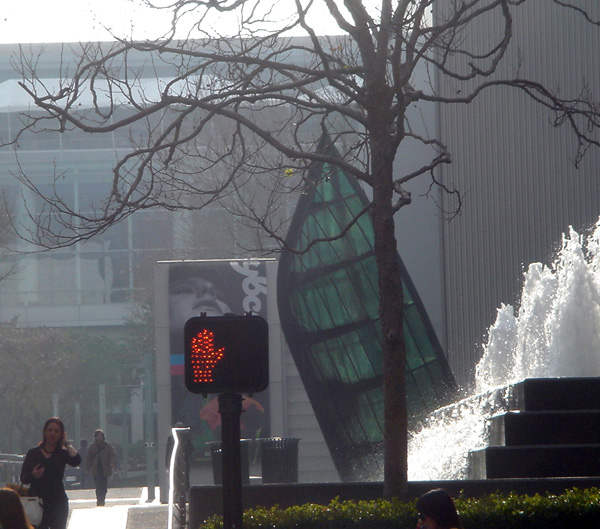
A Pyramid of Mind.
In both PS1 and PS2 I have three levels of intelligence in the natural world. The pattern is something like a pyramid with a broad base, a tapering hierarchy, and a single point at top.
(Base) A low level of ubiquitous entities which store data and carry out processing;
(Hierarchy) An extensive medium level containing a successive layers of AIs which first emerge as distributed processes based upon the low level but which then pile higher and higher upon each other.
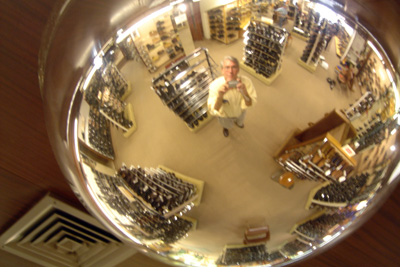
(Top) A top level containing a single entity that stores its data in the base level and which incorporates all the mid-level agents that are in the AI hierarchy. An alternate model is that there are two or three of the highest level entities, and they compete for the allegiances of the mid-level agents and for the base data space.

The PS1 Pyramid of Nanotech Mind
In my recently completed SF novel PS1: Postsingular, I implemented the mind pyramid as follows
(PS1 Base) The lowest level base consists of uniform hardware units that are molecular computers or nanomachines called orphids, each of which has about a gigabyte of memory and a gigaflop of processor power and is roughly as smart as a dog.

(PS1 Hierarchy) Emergent lifelike AIs resembling the Belusouv-Zhabotinsky scrolls found in cellular automata. They’re called beezies. They act as helpful agents for people, carrying out things like complex and tedious searches for information or simulating and evaluating multiple alternate action scenarios. Some groups of smaller beezies coalesce into single higher-level beezies, and so on in an upward cascade.
(PS1 Top) The so-called Big Pig, a god-like mind that people enjoy tuning in on. Communing with the Big Pig is something like a mystical experience or a drug trip. People who become addicted to this are called pigheads.

The PS2 Pyramid of Natural Mind
Now I’ll outline how I plan to realize the mind pyramid in PS2. Some of my ideas about universal analog computation are “explained” in the 2005 video below. I love putting in these YouTube links! By the way, you want to click the big transparent arrow you see the video. If you click elsewhere in the preview image you go to a YouTube page. And to stop the video you click the pause button. I know the sound quality is terrible; it’s the Big sur wind blowing across my pocket-sized SONY digital camera.(PS2 Base) Every bit of matter is endowed with endless “lazy eight” memory, and the computational seething of the quantum states provides the processing power. Using a word made up by the philosopher Leibniz, I call the lowest low level natural minds monads. Most simply, I can regard a monad as the mind of an elementary particle. (Eventually, but not yet, I’ll need to consider the effect, if any, of lazy eight in Subdee, the subdimensional world below the Planck level.)
(PS2 Hierarchy) The monads support higher-level intelligent emergent minds that I will call silps. An extended large object has a fairly hefty silp mind. Groups of objects have silps minds as well, as do larger regions: cities, counties, continents. As with the beezies, we have an upward-mounting hierarchy of silps.
(PS2 Top) The top level mind is Gaia, the world-soul of planet Earth.
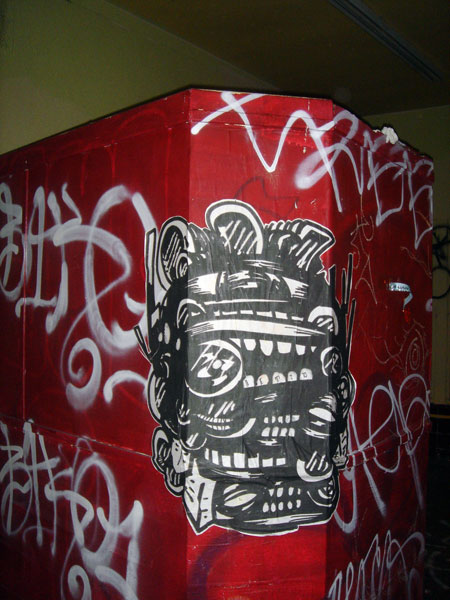
[Graffiti on former ticket kiosk of a closed movie theater on Mission Street. Is that a Mayan god, or what?]
The Transition From PS1 to PS2
(Eliminate the orphids.) At the end of PS1, lazy eight is unrolled, and the emerging silps immediately destroy some bad nanomachines called nants. The silps also destroy the orphids, even though the orphids were relatively benign. I eliminate the orphids because, applying Occam’s Razor, I don’t want to have two distinct low level ubiquitous computation networks in PS2. If I have monads, I don’t need orphids. A second reason to kill off the orphids is that I want to cleanse the world of digital machines.

(The Big Pig survives.) The Big Pig of PS1 manages to port herself or embed herself or somehow come into being within the Gaian mind of PS2. I require this due to the following considerations. The Big Pig is very smart and powerful, and if she had wanted to, she would have been able to prevent the lazy eight from coming about. She could, for instance, have killed Jayjay or the magic harp alien before Jayjay and the harp teamed up to unfurl lazy eight. But, to the contrary, the Big Pig repeatedly said she would be okay with the change, and that it might be a good idea, so evidently she believes she will in some form survive the transition. Given that she is smart enough to work out very deep consequences, we can assume that she’s correct in her belief that she will survive Therefore it must be that the Big Pig does indeed survive in some form or another.

(Preserve the data from the orphids.) In order for the Big Pig to survive, at the very least we have to assume that the data that was in the orphids survives. I believe that, given the data and enough computational ability, the Big Pig can regenerate herself. Like a Unix system recompiling itself. Like a simulated mind called PIG from a Windows machine coming into being on a Mac that’s been fed a PIG data disk. We’ll suppose that the silps read and store the data that was in the orphid nanomachines.
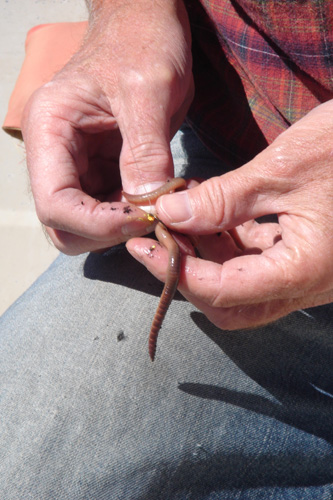
(Wipe out the beezies.) In PS1, the Pig sits at the top of the pyramid of the beezie hierarchy, but we can have her sitting upon a silp hierarchy just as well. Occam’s Razor tells me to wipe out the beezies so as not to have two hierarchies of mid-level minds.
Having absorbed the beezie data and beezie code that was stored in the orphid memories, the silps can in fact emulate beezies. But they are richer and quirkier than the emulations. I don’t want the silps to be exactly like the beezies. I don’t want to flinch away from the juicy problem of figuring out how it will feel to do telepathy with brute natural objects and with spirits of place. I want to teep into objects and locales that are just being themselves. I don’t want to devalue nature by having it taken over by the beezies, which are more like computer-science agents. I don’t want my awakened objects to be co-opted immediately. Perhaps later some evil aliens try to co-opt objects, but we don’t want it to happen by default right away.

This said, the beezies were quite human friendly, much more so than we can expect the silps to be. So if we lose the beezies then we lose some mental power. Unless the silps are more helpful than I expect them to be, humans lose much of the intelligence amplification (IA) that they had enjoyed by using beezies as virtual agents. In any case, humans do still have considerable IA in that they have omnividence, telepathy, and “mental Google.” All that’s now missing is the ability to effortlessly conscript beezie mind agents.
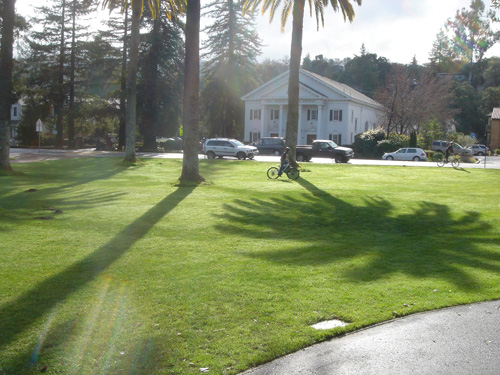
Comparing the Noospheres of the Lobrane and the Hibrane
In my postsingularity series, I have two parallel worlds, our Lobrane and the another world called the Hibrane. The Hibrane’s lazy eight unfurled five hundred years earlier than ours. They never had a need to develop our type of high-tech digital science; in particular, they never had nanomachines. And their local silps were careful to exterminate any nanomachines that we might have brought in when we began traveling there during our relatively brief nanotech era preceding our own lazy eight.
As kind of legacy from our nanotech era, our Gaian mind is somewhat Internet- like. She inherited the base-level data of the Big Pig, and reconstructed the Big Pig as a kind of interface. Having absorbed the data and the beezie program routines stored in the former orphids, our silps are fairly personable and adept at communication
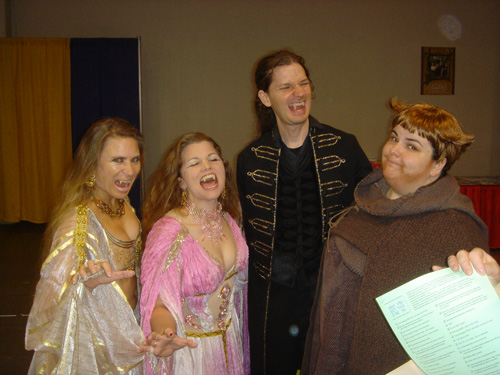
The Hibrane’s native computations are relatively unsophisticated, as is the Hibrane’s planetary mind. The Hibraners can’t “Google” their objects. Some of our silps will emigrate to the Hibrane by riding upon humans who travel to there and by then hopping over to Hibrane matter. But the few silps that we transfer will not be able to carry across the planet-sized data base and code legacy that our orphids and nants created during our nanotech era.
Given that the contemporary Hibraners’ silps are unsophisticated, it has to be that our silps can’t easily upgrade them. For, due to a bend in the direction of our Lobrane timeline, some of our silps will in fact emigrate to the Hibrane’s past. If they could upgrade those past Hibrane silps, we’d have a time-paradox, given that the Hibrane silps we saw in PS1 were relatively primitive.
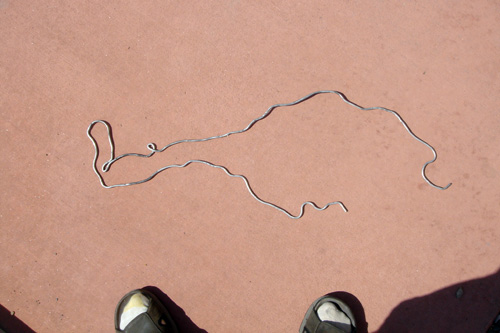
About Silps
To the human eye, a rock appears not to be doing much. But viewed as a quantum computation, the rock is as lively and seething as, say, a small sun. Up till now I’ve been placing a high premium on visible and human-scale forms of gnarl: wobbling leaves, flowing water and flickering flames. But now I realize that, if I look at the atomic level, there’s all kinds of stuff going on in a rock. For instance, in a crude molecular model, a rock is like a zillion atom-balls connected by van-der-Waals-force springs, and we know this kind of compound oscillatory system behaves chaotically. My point is that even a dull-looking object constraints enough gnarly natural computation to support a sophisticated silp.

We’ll also have the higher-level silps that are genii loci of spirits of place. Maybe I need a better word for these. Local silps?
When I decided to have all objects come alive in this novel, I was thinking of, like, Disney or Crumb-style teapots and clocks and spoons and hamburgers and salt shakers, each object an eager little pal. But we can also have surly silps. The silps might sometimes be like the peyote-trip vision I had in 1964, of tree branches like evil claws. (Disney shows this kind of animistic vision too, come to think of it, in scary lost-in-the-forest scenes.) Certainly those spirits of place I saw in the creek bed when I was lost in Big Basin weren’t friendly beezies. They were, at best, indifferent.

Self-Teleporting Objects?
I definitely don’t want objects to be teleporting, at least not for now. But mightn’t an object want to hop around to improve its situation? Naw, an object computes the same wherever it is. I want objects to be disinclined to move around. They’re, like, fully enlightened, each object like a tiny guru on a tiny mat, with no thought of doing anything other than going with the flow. The higher-level silps can move around, but in the style of programs in the web; the high level silps could move simply as information patterns, and wouldn’t need to move the hardware around.
I’m worried about smart fire, though. If flames teleport, maybe the planet goes up in a firestorm. Or maybe the smart trees know to bend away from the flames. Fire and trees chasing each other around…

If I start out with the objects being mellow and inactive, then this is something that the Kang’s enslavement might interrupt, making objects restless, to very bad effect. So by making the restriction now, I gain a plot point later on.
The flow could be that (a) the silps start out just as themselves, natural, some of them slightly hostile or at least selfish, some of them friendly, then (b) the Kang can’t get to the high-level silps or to the Big Pig/Gaia, but they are able to exploit our monads and low-level silps and in this makes silps a bit more awake and discontent, and then (c) after we block the Kang, there is some residual revolutionary fervor in objects and maybe they are teleporting and making trouble. Maybe the objects march en masse against the Kang. Try finding my glasses then!

What About Animals and Plants?
It’s natural to think in terms of a great chain of being:
Monads, Silps, Plants and animals, People, Society, Gaia.
How does a human’s or an animal’s old-school mind relate to the silp mind of their enhanced body? I’d want to see these as merging; wouldn’t like to have the mind-body problem turn into an ongoing debate, with two voices in your head.
I feel like plants should have somewhat richer silp minds than mere stones, but maybe that’s a prejudice. Might a stone be as heavy a thinker as man?
Will society actually have a group mind now?

[I took two photos of a painting by Robert Bechtle at SF MOMA the other day. It’s bizarre what the perspective does to your perceptions; from one side the car looks too long, from the other it looks too short.]
Googling the Silps.
Thanks to the legacy ware from the orphids and beezies—the data and beezie-code—the silps have the concept of URL addresses and networking, which is convenient if you lose something. Finally you can “Google” for missing objects. Certainly I was thinking of this the other day, looking for my lost glasses in the forest floor duff. In PS2, I’d be able to telepathically find my glasses. For I know the vibe of my glasses, I can feel them out. This doesn’t have much to do with the fact the glasses have a memory.
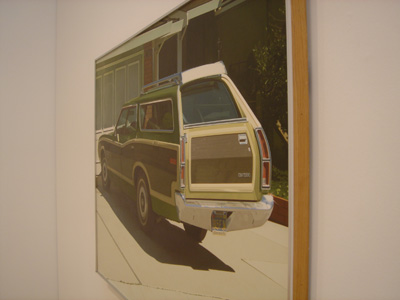
Direct Contact with Silps.
What kind of mental contact do I have with silps?
Talking to objects is at the core of what’s important to me. I had a stab at it in my story, “Panpsychism Proved.”: “the mind she’d linked to was inhuman: dense, taciturn, crystalline, serene, beautiful—”
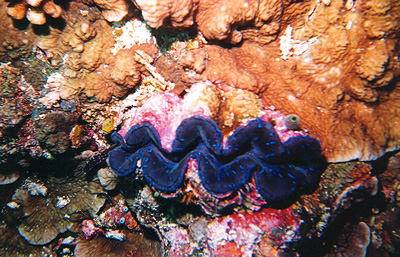
Whaddaya say?









January 29th, 2007 at 10:05 am
You realize you’re encrouching on my own quantum tantra territory by making everything talk—not just on panpsychism and Walt Disney—so I’d be happy to share some of the “insights” I have about what a quantum tantric world might look like.
The most intriging property of the quantum world is the notion of complementarity—that you can ask one question (momentum?) or another (position?) but not both and that somehow the world contains both but you can’t get at it. There is also the possibility of asking questions that were simply inconceivable in a classical world such as P + iX? (we can actually ask this P + iX question of a light beam).
So one way that quantum tantra could be implemented is if we could find some classically nonsensical ways to address the macroscopic world that produce entirely novel and unexpected outcomes.
I suspect that consciousness is one of these answers that the world gives to a weird-ass request and that there are more ways of being out/in there too that can be discovered by learning to ask to right questions.
The motivation to ask such questions would come not from mystical experiences or sacred books but from asking similar questions at the micro-level, something we humans have only been doing for a couple dozen years.
January 29th, 2007 at 2:59 pm
hello i have a question – do parts of a human body other than the brain become sentient as well? – if so, we’d be carrying a silp around with us, like etheric parasite beings that my cousin once believed he had (!). if not, you’d have to believe against modern science that the mind is distributed throughout the body, and not located in the brain. or maybe there was a transformation of humans that occured after the lazy eight unfolding and we turned into something new ourselves.
(forgive me if this makes little sense, this is very complicated territory for me, your thoughts).
maybe you will be interested in watching a video on youtube made by an autistic woman, who has her own language that she describes as ‘being in constant conversation with every aspect of my environment’ – wouldn’t a panpsychic world really, really change the way we are? i cannot link out of fear of the SPAMBOT, but you can look for ‘in my language’ by silentmiaow.
power! – and all the best.
January 30th, 2007 at 10:40 am
You need to see Rivers and Tides, the documentary about Andy Goldsworthy. I was reading your recent posts about Hylozoic (cool title…reminds me of one of my favorite sf titles, Cryptozoic) and then this evening I watched Rivers and Tides.
This guy totally lives in the hylozoic world. I had some books of his art, but this is a much better look at what he thinks he’s doing.
January 30th, 2007 at 1:16 pm
Excellent! The porting to wordpress worked. Got all the comments!
January 30th, 2007 at 8:40 pm
On a tangential note, I really like the blog’s new layout. Much more user-friendly.
January 31st, 2007 at 9:16 am
Seach for this “in my language’ by silentmiaow” at video.google.com the video is definantely has qaulites of some of your videos. These days seach at video.google.com I believe searches the enire web, which was always a goal. There are a bunch of hits for this search.
Lots of thoughts to pass by you but not this morning.
However, one problem that I think would be interesting for you to solve is the search problem in the PS2 world. I.e. in our world effective seach ala Google requires massive indexing and massively distributed hierachical computing. Does something analogous happen in PS2 (or PS1)?
January 31st, 2007 at 2:02 pm
Rudy, I wrote a long rant yesterday but got slashdotted for saying “C—roach.” Maybe I can remember half of it:
I don’t see sentient fire working unless all fire connects to a great goddess of fire who lives in a volcano (call her Pele) – otherwise fire would either be fighting for survival or watching in horror as its fuel dwindles. Fire wouldn’t have much to say except “Quick, throw me some gasoline!” unless it had a survival strategy.
I can’t see why exactly nonliving objects would become actively intelligent – with no instincts or desires, what would they reach for or wonder about? You have it right when you say they’d be little gurus meditating, already in nirvana at birth. I suspect silps who spoke would be rare, maybe inspire pilgrimages. Sometimes a silpmind might coalesce around fragments of beezie code, but when the new mind booted up it might find life as a pebble onerous or horrifying and delete itself again (“Help, I’m a rock!”).
Sentient dogs and cats might be very common and dangerous. As smart as we are and with less morals, they could become a new criminal class. Insects could be very dangerous – hordes of hyperlinked roaches might be a menace. And as alek suggests, you might have to defend against your organs, or intestinal flora, becoming sentient: Your pancreas is on line one, sir.
The Big Pig might be reduced to bacon, and happier that way. One Pig is a target, while a whole herd of piglets would be much harder to eradicate. Individuals might keep their own pig seeds in case there’s no Big Pig when they need one – a Piglet would grow quickly by accessing hidden data dumps. Newly-instantiated swine would owe you one for starting them up; if no Big Pig existed one would achieve bigness very soon. This might ensure that the Big Pig Jig went on for thousands of years instead of putting all your pigs in one poke.
So, they could be inimical and we’d need to be able to turn some of them off, or else have talking testicles. Ever read Fred Brown’s oldie “The Star Mouse?” Little Mitkey, unwitting test pilot of a mouse-sized rocket, came back with an electrical field around his brain which gave him human-level intelligence. Alas, an electric shock wiped his mind back to mouse-level with a squeak. That would be a handy trick if, say, a garden gnome took over the planet or your kneecap went on strike; just erase them. Every doorway might have a silp-remover field to prevent your pocket change from screaming “don’t spend me, daddy,” or your rings and jewelry from demanding jewelry of their own. Some objects should be prevented from becoming intelligent, like insulin syringes or toilets; for their own good we should make them silp-proof. So, maybe you wouldn’t be able to call your glasses, but all the surrounding silps could point them out if they felt like it.
I think you’ve had a key insight that some of them might be angry or cold, and not very good company. When you talk to objects, they might say “Are you talkin’ to ME?”
March 7th, 2008 at 11:34 am
None…
None…